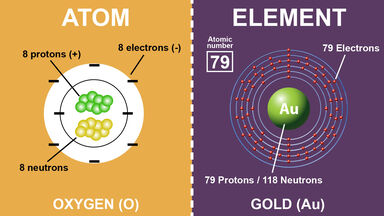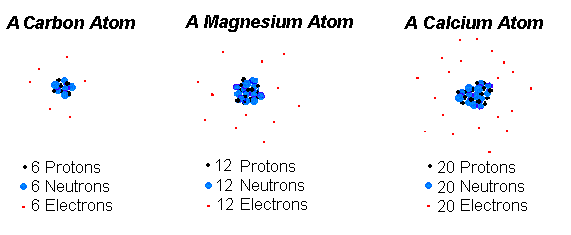Explain What Makes One Atom Different From Another Atom
Key Difference Bohr vs Quantum Model The Bohr model and quantum model are models that explain the structure of an atom. The number of protons in an atom is the defining feature of an atom.

Difference Between Atoms And Elements With Examples
Molecules are groups of two or more atoms that are chemically bonded.

. What makes atoms of one element different from the atoms of another element. Two atoms of the same element can be different if their electrons are in different states. 9 Atoms of different elements with different mass numbers but same number of neutrons 10 Atoms of different elements having same atomic numbers DOWN 2 Atoms of same element having different mass number 3 Number of protons in an atoms 4 Proposed planetary model 6 Fundamental particle with no charge 7 Number of protons and neutrons.
As atoms get more massive with higher atomic number they get more electrons and these electrons are layered around the atom in concentric shells. However their arrangement always follows the same set of principles. It is not possible to break down atoms any further.
Explore examples of elements and atoms. They differ by the size of nucleus as volume of nucleus is directly proportional to the mass number of the atom. This type of bond forms between a metal atom and a.
Atoms are the simplest unit of a matter. The number of protons in an atom is called its atomic number. An element is a substance in which all of the atoms have the same atomic proton number.
However molecules always exist independently or in a free state. Protons and neutronsin the atomic center electronsin orbitals at energy levels electrons always occupy the lowest energy level possible A Matter of Stability. And for atoms to bond they must do at least one of the following.
These atoms usually form ionic bonds with each other. The changing of one element into another called transmutation involves a change in the nucleus of the atom. An atom is the smallest component of an element containing neutrons protons and electrons and makes up everything around us.
Therefore to be precise atoms are the smallest part or amounts of elements. Bohr model is also called Rutherford-Bohr model because it is a modification of the Rutherford model. Gain electrons from other atoms lose electrons to other atoms share electrons with other atoms And recall that valence electrons occupy the highest energy orbital in an atom.
An atom is the smallest particle of any element whereas a molecule is formed when two or more atoms are held together with the help of a chemical bond. Since the number of electrons in a neutral atom equal the number of protons This means the atom is larger as the. An atom can be an ion but not all ions are atoms.
Splitting an atom creates different elements split an oxygen atom and you dont have oxygen any longer. The number of protons in the nucleus which is generally equal to the number of orbiting electrons is what distinguishes atoms of one element from atoms of another element. Atoms differ from one another in the number of protons neutrons and electrons they contain.
The number of protons in the nucleus outermost energy levels contains electrons. In general the more electrons in the atom the larger the atom. Bohr model was proposed by Niels Bohr in 1915.
Most of an atom is empty space. There are distinct differences between an atom and an ion. However atoms and elements do have a few differences when you start breaking it down.
By definition an ion is an electrically charged particle produced by either removing electrons from a neutral atom to give a positive ion or adding electrons to a neutral atom to give a negative ion. Atoms use their valence electrons to bond with other atoms. Many people might think atoms and elements are the same.
The main difference is elements are made of atoms. These electrons are negatively-charged particles. Bigger atoms have more shells of electrons.
Protons and neutrons form the nucleus of an atom and a cloud of electrons orbits the nucleus. And they also differ by the wavelength of light produced by them when an electron jumps from higher energy state to lower energy state. What makes one element different from another is the number of protons in the nucleus of its atoms.
In their center atoms have a closely packed nucleus. Atoms are made up of three subatomic particles. Although one could claim that these two words are strongly connected they are widely different.
What makes one element different from another atom based on atomic particles. Total electrons must be 8 energy levels electrons are in energy levels outside the nucleus Related questions QUESTION What is newtons 2nd law of motion. The number of protons determines an elements atomic number Z and distinguishes one element from another.
What distinguishes neutral atom from an ion. Its what makes one element different from another. A large difference between electronegativity values between atoms indicates one atom is attracted to electrons while the other can accept electrons.
What makes an atom of gold different from an atom of iron is the number of protons neutrons and electrons inside it. First of all there is a range of possible states that the electrons of an atom can occupy. For example carbons atomic number Z is 6 because it has 6 protons.
Two different atoms will have different size of atom and nucleus. The number of neutrons can vary to produce isotopes which are atoms of the same element that have different numbers of neutrons. And the number of protons in the nucleus must change for one element to become another.
Properly only something with molecular bonds can be called. A molecular bond or by completely transferring electrons from one atom to another an ionic bond. It is possible for atoms to either exist or not exist independently.
Quantum model is the modern model of an atom. An atom is the smallest particle of an element that retains the properties of that element. The nucleus in the center is surrounded by clouds of electrons.
This is the primary difference between an atom and element. Learn other differences between atoms and elements by dissecting these two terms. One element differs from another element by the number of protons in their atoms.
They contain the same number of protons as electrons. Splitting a scoop of ice cream results in smaller blobs of the same flavor. If an atom were about as big as a baseball stadium the nucleus would be the size of a pea in the very center and the electrons would be somewhere on the outside edge.
The number of protons in the atom is. Ions are atoms or molecules that have gained or lost one or more of their valence electrons and therefore have a net positive or negative charge. If one copper atom has an electron in an excited state and another copper atom has all of its electrons in the ground state then the two atoms are different.

Atoms To Molecules Earth Science

Atom Atomic Mass And Isotopes Britannica

Atoms And The Periodic Table Activities Game For Learning Atomic Structure Middle School Science Classroom Science Chemistry Teaching Chemistry

No comments for "Explain What Makes One Atom Different From Another Atom"
Post a Comment